

At he age of 15 Don worked on a horse seining ground for 3 dollars a day and 50 cents a day bonus for working the whole season.
Because his father suffered bankruptcy it was not possible to start college out of high school.
Don worked for the Pittsburgh Flour Mill, which at the time, was the largest volume export mill to the Far East in the country. He worked nights and weekends loading ships. In the summer of 1939 a close friend of Don convinced him to quit the mill and enter the college. In August 1941 Don sold his car and started the university of Oregon in September.
College was an exhilarating experience for Don even though he worked washing dishes in the house and as a sorority houseshop.
He was in his first semester
at the University of Oregon in the fall of 1941 when the Japanese attacked
Pearl Harbor.
He was in the kitchen pantry area washing pots and pans when a house member
ran in the kitchen to say the Japs had bombed Pearl Harbor.
Don was naive enough to ask: "Where in the hell is Pearl Harbor"
an embarrassing query from someone tabulating straight 'A's in geography all
through school.
All chapter members during the next week talked of going into active military
service. On the 15th of December 1941 Don hitchhiked to {Portland (Oregon)
for XMas vacation and noticed a Marine recruiting sign. He tried to enlist
in the Marines. The doctor said he was a 100% physical specimen and send him
to to dentist. He was turned down because of dental problems and the dentist
offered him no explanation.
The mystery would unfold a a postwar family reunion at his grandparents home.
The husband of one of his father's sisters who was a career Naval Officer
told him that an 1800's provision stipulated that if certain molars were missing
the gas anesthetic device used in surgery would not work. It had to do with
the rocking of early Naval sailing ships.
He later tried to enlist in the Army Air Corps, but he lacked the mathematics requisites. When he was drafted in July 1942, he volunteered for the paratroops of the United States Army, becoming a member of Easy Company, 2nd Battalion, 506th Parachute Infantry Regiment of the 101st Airborne. He received the Bronze Star Medal for his involvement in the Brécourt Manor Assault on D-Day in Normandy.
Over Christmas vacation Don read an article in the Readers Digest describing the glamour of parachute troops "Go on a mission for a few days, get picked up and return to your base!" He mentioned to his mother that he was going to volunteer for that service and her reaction was very emotional. His dad's two brothers were killed in the first World War. Don returned to college and in April he took the exam for pilot training which he ended up walking out on as he could not handle the math due to the limited courses he had at the catholic schools he attended.
He registered for the
draft and was notified to report in August 1942. The owner of the plant where
he worked offered to get him a deferment but he refused. Don quit his job
at a machine shop where he did extensive defense work for liberty ships. He
spend a few days in Astoria and ran into a friend who was already in Fort
lewis. He told Don the first thing that was asked in the initial indoctrination
at Fort Lewis was for volunteers into the parachute troops. He had made his
mind up as to what he was going to do.
His first visit was to his parents who were living in their summer cabin.
The few days there flushed his brain with the memoirs of all the fishing,
hunting, camping and berry picking that had been so much a center point of
his life.
He left Portland without telling his mother of his plans and reported for
active duty on september 12, 1942.
Don was send out of Portland by rail in a group of 100 inducters.In Fort Lewis
they were directed to an indoctrination center. As he was told the first question
asked was for paratroop volunteers. Two of them stood up and were escorted
to the front table were they both signed paratroop pledged. The were escorted
out of the room and given special physicals. The other volunteer was rejected.
Two days later he was on his way and in St. Louis he joined a group of a half
dozen other volunteers who. likewise, were on their way to Toccoa Georgia.
He was placed in W-Company, a tented area with fall rains running through
the tents, reserved for both washouts and new arrivals. Later on Don was assigned
to Easy Company, 2nd Battalion, 506th Parachute Infantry Regiment, 101st Airborne
Division.
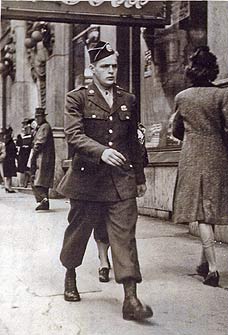
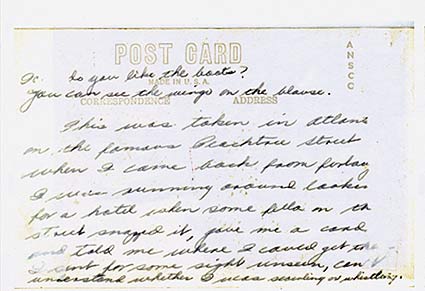
Don volunteered for the paratroops because he wanted to be in a high risk all-volunteer outfit.
Later during his time with Easy Company he was promoted to the rank of Sergeant, and served under the command of Lt. Richard Winters, later promoted to Captain and then Major. Malarkey was involved in combat in Normandy, Operation Market Garden in Holland, Bastogne, and Germany.
As effective commander
of Easy Company, 2nd Battalion, 506th Parachute Infantry Regiment of the 101st
Airborne Division during D-Day, First Lieutenant Richard Winters was tasked
to take on a battery of German 105 mm howitzers that were firing onto causeway
#2 off Utah Beach. Some other units had stumbled onto the enemy position head-on
earlier in the day, and were repulsed.
About 0830, Winters gathered a team of thirteen men from his and other companies.
Knowing little more than a general location of the gun emplacement, his team
scouted the area north of a farm house called Brécourt Manor, located
3 miles west of Utah Beach, just south of a small village Le Grand-Chemin
(near Sainte-Marie-du-Mont). There they spotted a battery of four 105 mm guns
connected by a trench network and defended by nests of MG42 machine guns.
In total, they were up against about fifty German soldiers.
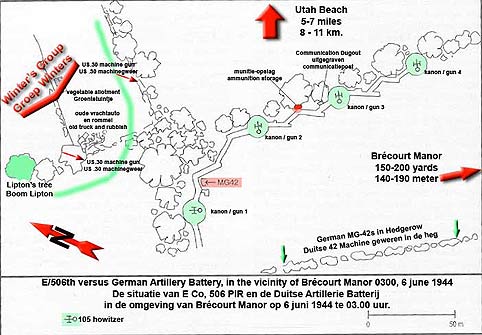
While the trench network linking all the guns was sound military practice by the Germans, providing them with an easy way to re supply and reinforce the guns, it also proved to be their biggest weakness; after taking out the first gun position, Winters' team attacked the remaining guns by using the trenches for cover and approach routes. The danger of the trenches to Winters' team were that they were extremely vulnerable to grenades. Reinforcements from D (Dog) Company, led by Lt. Ronald Speirs, arrived to aid the assault on the last gun. After the four guns were disabled, the small team was low on ammunition and withdrew.Winters had discovered an enemy map in one gun position that showed all of the German artillery and machine gun positions throughout that area of the Cotentin Peninsula. This was an invaluable piece of intelligence and was handed up the chain of command. Later, when two tanks from Utah Beach arrived, Winters directed their fire to clean up the position.
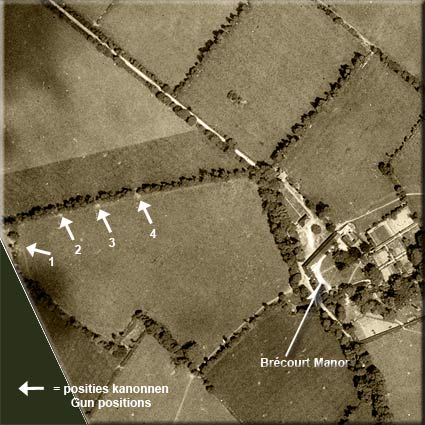
Winters lost one man under
his command, PFC John D. Hall from 2nd Battalion's Headquarters Company, and
another one of his men was wounded during this attack, Private Robert "Popeye"
Wynn from Winter's squad."
Troops landing at Utah Beach had a relatively easy landing, due in part to
this successful assault to destroy these guns.
Colonel Robert Sink, the commander of the 506th PIR, recommended Winters for the Medal of Honor, but his award was downgraded to the Distinguished Service Cross because of the D-Day policy of granting only one Medal of Honor per division, which was awarded to Lieutenant Colonel Robert Cole. However, at the time of the writing of this article, there is a campaign to upgrade Winter's Distinguished Service Cross to the Medal of Honor as many felt he deserved.

![]()
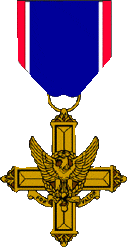
Distinguished Service Cross
Dick Winters

Cleveland Petty - Walter Hendrix
Donald Malarkey - Myron Ranney
Joe Liebgott - John Plesha
Silver Star
Lynn "Buck" Compton
Bill Guarnere
Joe Toye
Gerald Lorraine
The 13 involved E-Co members were awarded as shown above.
The official Army history of these events on D-Day is quiet about the battle. Army historian S. L. A. Marshall did interview Winters about the attack, but the interview was not private -- many of Winters' chain of command were present -- and, according to his Memoir "Beyond Band of Brothers," he may have downplayed his description of the event to avoid personal accolade and keep the account succinct. However, nearly every man involved was later recognized for his role in the attack.
The assault has been widely acclaimed as a textbook assault on stationary gun positions and is still enacted for training purposes at the United States Military Academy at West Point, New York.
More about Don's experiences he told in an interview you can find on page 3.
In 1984
Don, together with his wife Irene, visited Brécourt Manor after 40
years. Back again at the spot where they fought this magnificent battle.
Below some photos made during that visit.
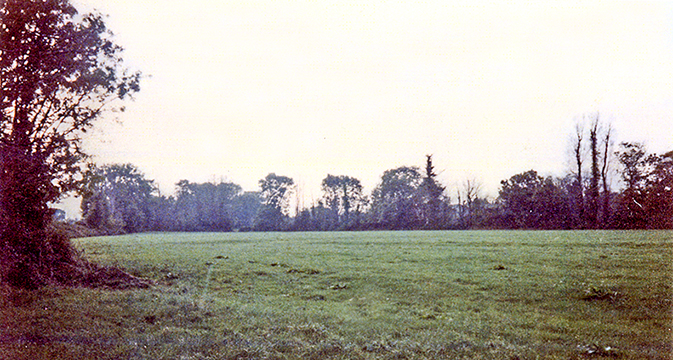
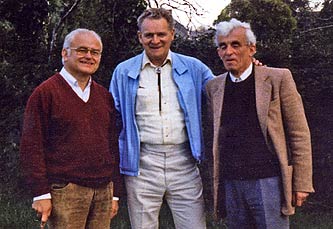
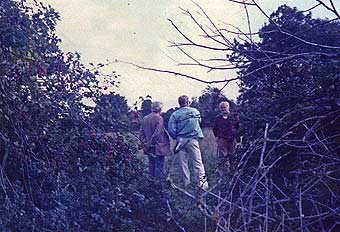
pages
1 - 2 - 3
INDEX
Some
of the photos on this website were taken by Peter van de Wal. I assert the
moral right to be recognized as the photographer and the owner of these images
in any form. If you wish to use these photos for noncommercial purposes I
consent to such use as long as the source of the photos is clearly acknowledged
in the same publication as the photos you wish to reproduce.
Photos of WWII documents and WWII photos are courtesy Don Malarkey©.
"Band of Brothers" & all related marks & media are TM
& © 2001 Dreamworks Television & HBO. This site is in no
way affiliated with any entity involved in the production of this film.
All opinions contained here in are not intended to infringe on any copyrights.
For remarks or comments please mail
me.
Peter van de Wal ©